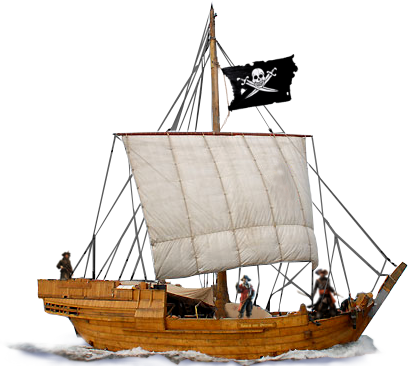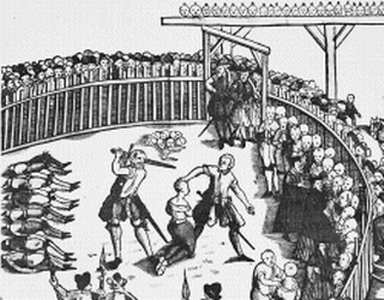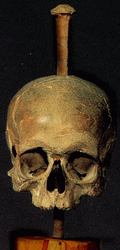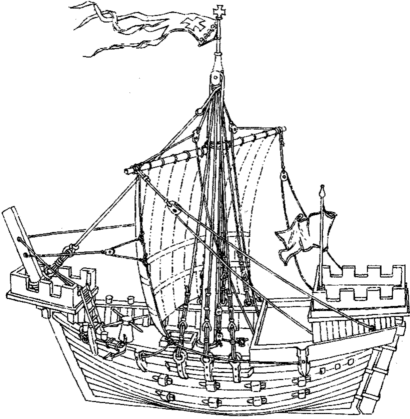Pirates

Hinrik and Jakob Hunninghusen - Year 1491
The following report is based on data of Hanserecesse 1477-1530, Vol. 2,3,4 (Dietrich Schäfer, Leipzig 1881 ff), of Hansisches Urkundenbuch (=HUB) 1486-1500, Vol. 11 (Höhlbaum, Kunze, Stein u.a., Halle 1876 ff) and of Caspar Weinreichs Danziger Chronik (Hirsch und Vossberg, Reprint 1973).
About the Piracy of the Hunninghusen in the Baltic Sea
Thanks to
HELEN SCHIAVONE (nee Hennighausen) for correcting my mistakes !
( © Dr.Helmut Hennighausen)
Über die Seeräubereien der Hunninghusen in der
Ostsee - in Deutsch 
First
evidence of possible illegal actions of the Hunninghusen are to be
found in the Hansische
Urkundenbuch, Vol. 11, Doc. 23.
On March 17 of the year 1486
Hinrik Hunninckhusen from
Reval, son of the councilman Hinrik
Hunninchhusen, confirmed on oath, not to seek for revenge
against Lübeck and some Lübeck councilmen, because of having
been innocently imprisoned in Lübeck. He was supposed to have
obtained 1650
Mark
Rigisch for goods, which Wilhelm van
dem Velde removed from Hans
Westfal`s ship from Wisby
on the island of Gotland. In a letter sent from Wisby to Danzig on July
21,
1486 (Doc. 52) the knight Iwar Axelsson from Wisby testified
on oath, that the Reval councilman Hinrick
Honnynghusen the Young, son of the old Herr Hinrik, did not ever receive any wax
or furs from him, which had been stolen out of Hans Westfal`s ship, and
that Hinrik had been imprisoned in Lübeck
innocently.
Ivar Axelsson Tott received
Gotland from the Danish King in 1465. He was successor of
his brother. He improved his economic situation through raids and owned
much of the land in the Baltic Sea area. The pay-rolls of the year 1485
testify the expendable lifestyle of Ivar Axelsson. History calls him
the Parasite of Gotland. In a letter sent from Lübeck to Reval on
August
6,
1486 (HUB,
Vol. 11, Doc. 53) one can read, that the knight IwarAxelsson
rigged seven ships on Gotland, perhaps with intent to take
away goods from Reval and other merchants. They
advised
Reval to let their loaded ships sail together and to man the ships with
mercenaries in order to protect their goods against the warriors of
Axelsson.
The first direct reference to
piracy of
the Hunninghusen can be found in a letter from the German Comptur in
Antwerp to Lübeck dated May 9, 1491
( Danziger
Chronik, page 71 ), which was handed from Lübeck to
Danzig on May 21 ( Hanserecesse.
Vol 1, Doc. 482 ). He reports warns of ships that would be
rigged for Bertram Hoike in London and also in another
English harbour for a person called
Hinrich Hunninghusen. Indeed
these ships arrived soon in the Baltic Sea, one ship under command of
Hinrich Honighusen, which had English emissaries on board. He set
the emissaries ashore in Copenhagen and returned back to his brother Jacob Honighusz and his robbery
comrades, all of whom stayed in the Gothenburg area. Lübeck
believed that they enforced their crew and ships under protection
of
Hinrich Krumdik, captain of
Bohusen Castle, and then started their raid into the Baltic Sea.
Around mid of June Jacob H.
came from Copenhagen into the Baltic Sea and captured five ships near
the island of Bornholm, which were sailing from Lübeck to Danzig: Matias
Schmidt, Hermen Reiniken, Hans
Tesken, Lorenz Tide and one, whose name was Hans Franke, on the way from
Reval to Lübeck. Danzig suffered a damage of linen (cloth) and
other goods worth 14.000 Rheinische Gulden and Lübeck 5.000
Rheinische Gulden. An exact nomination of the aggrieved merchants and
their losses can be found in Hanserecess,
Vol. 3, Doc. 10. The Hunninghusen sailed with the robbed goods
to Kungel near Bohusen in Norway (today Sweden). Hermen Reiniken was
the only one they let sail away from Bornholm. They removed all goods
of
his ship except a little salt.
Kungel (today Kungälv) is the castle
Kongself on the river Gothaelf. On the opposite side of the river, on
an
island of the Gothaelf the
castle
Bohusen was located. Hinrich Krumdik was the commander of
both castles and the
harbour of the island of Marstrand
west of the castles.

The Fortress Bohus in Kungälv
Click once in picture and scroll with Ctrl and mouse wheel the map.
In the year 1455 German merchants in Bergen killed Oluff Nielsen, the governor of the king of Norway during a riot. They burned down the Munkelef monastery, where Nielsen took shelter. The bishop, several clergymen and 60 other people were killed. In consequence relatives of the murdered Oluff Nielsen, who sought revenge, started a profitable pirate-war against the Hanseatic league. Nielsen`s son Axel and his daughter Magdalene declared war against the Hanse. Although the merchants in Bergen payed 7000 Danish Marks to the Nielsen family for the death of Oluff, the family or rather the pirates continued to rob the Hanseatic ships.
One of the most dreaded pirates engaged by Magdalena Nielson was the above mentioned Bertram Hoike, who caused extraordinary harm to the Hanseatic people in 1490 and 1491, until he was executed in Helsingör. Previously he had already haunted people in Liefland. He is told to have had his headquarters in Samayten, from where he started his raids during wintertime on Liefland by crossing the frozen rivers. In Helsingör he took away the herring of the fishers and the cattle of the farmers. He was captured and decapitated in Helsingör. In the middleages the heads of the decapitated pirates were poked on poles for warning and deterrence.


Jacob Honnighusen also was engaged by Magdalena Nielsen in the year 1491. She had bought a cravele (= ship) from Oloff Stigson, captain of Wartburg (Varberg), and gave it to Jacob H. to do harm to the Hanseatic league. On one of his raids he captured the ship of Hans Hasenbandt (Hasenbach, Husenbanck), who sailed from Lübeck to Danzig. However the ship was recaptured by the Danzig skipper Hans Broit (Preuth, Preyth). Jacob H. escaped to his place of refuge, Kungel, in Norway. When he went ashore he was caught and imprisoned in Bohusen castle. His ship sailed again, but seven seamen of the crew were from the Hasenbandt ship. They had joined the pirates in order to save their lives. When the ship crossed the Belt towards the Fehmarn Sund the seven seamen assaulted the pirates, two were killed and the other pirates were brought to Rostock, where they lost their heads. Two pirates escaped.
 |
About the same time Nicolaus, bishop of Roeskilde, sent a ship, which Jacob H. used for piracy before, to Gotland. This English ship however remained in the Baltic Sea and did a lot of harm to the Lübeck trade. Lübeck captured this ship in the hope to catch Honighusen. The crew admitted piracy and was executed. King Johann from Danmark accused Lübeck of killing his "innocent servers". He gave order to the captain of Bohusen, Hinrich Krumdyk, to attack the Hanseatic league and raised new taxes to the German merchants in Helsingör and Schonen. |
October 5, 1491 the merchants of Bergen wrote a letter to Johann King of Danmark. They complained about Jakob Heningkhusen, who had captured a Bergenship and asked to assure and obtain peace. In November Lübeck wrote to the merchants in London and directed them to also pursue the piracy of the Huninghusen in England. February 1492 King Henry of England gave answer to all Hanseatic towns (Hanserecesse, Vol.3, Doc.60 ). He assured to force Heinrich and Jacob Huninghusen, who had robbed with ships equipped in England, to return the ships and replace the goods of the Hanse. He declared, that he never supported the Huninghusens in any way and that he only sent his emissaries with one of their ships to Danmark. He promised not to obstruct a lawsuit against the Huninghusen as soon as they come back to England.
On November 16, 1491 all Wendisch towns, except Stralsund, attended the conference of Wendisch cities in Lübeck . Attending were envoys of the King of Danmark, bishop Nicolaus of Wiborg, the knights Erich Ottesen from Björnholm and Hans von Ahlfeld, the dome minister of Schleswig Einwald Sovenbroder, the varlets Hans Ranzau and Jacob Anderssen (Eriksen). They discussed the piracy of the last two summers and the conflict with the Danish king. King Johann of Danmark had tried to restrict the Hanseatic trade with Danmark. The raids of the Hunninghusen, which started from Danish ports and waters against Lübeck and Danzig, were discussed. The dukes of Mecklenburg were asked to arbitrate and they worked out contracts regarding loss settlement between the enemies.
October 18, 1494 archbishop Johann von Lund informed Danzig about the Henninghausen (Henningus Huusen) and wrote that they had sold the stolen goods in Danmark and that the goods were partly acquired by Herrn Laxmann and Nicholaus Ashonis. Danzig`s petition concerning the return of these goods to their owners would be discussed as soon as the king would be back in Danmark ( Hansisches Urkundenbuch, Vol.11, Doc. 779 ).
Regarding the family historical aspect, it is of some interest, that "the harm was done by a person named Hunningkhusen, perhaps from Reval" (Hanserecesse, Vol.3, Doc.32, Abs.12 ). A letter sent from Reval to Dorpat on November 20, 1494 in connection with the capture of the German merchants in Nowgorod and the Russian-Danish alliance gives informations on Jakob Hunninkhusen`s destination (Hanserecesse, Vol.3, Doc. 453 ). They say that he would currently stay with Prince Iwan III. in Moscow and received remarkable presents from the prince.
Comment: The spelling of the the name Hunninghusen / Honinghus /etc. was taken from each cited document.
Genealogy of the Reval Hunninghusen:
Berthold Hunninchusen
I (Tafelbruder 1399, councilman 1413,
1416-26, mayor 1427-1430)
I * um 1370,
+ 1434
I
I____ Arnd Hunnynckhusen
(Tafelbruder 1416 )
I * um 1390, + 1448
I
I_____ Hinrik Hunninghusen
I
I (Tafelbruder
1437, councilman 1456-1494 )
I
I *
um 1415, + um 1495
I
I
I I____ Arnd Hunninghusen (dome
priest)
I
I
* um 1440, + 1514
I
I____ Iwan (1) Hunninckhusen
I
I (Tafelbruder 1497, Pfandherr of manor Sauss 1497)
I
I
* um 1450, + um1538
I I____ Thonnies Hunninckhusen
I
I (councilman 1499 )
I
I
+ 1527
I
I____
Hinrik Hunninghusen (Pirate)
I
I (councilman1486, 1491 pirate)
I
I
* um 1450
I
I____
Jacob Hunninghusen (Pirate)
I
I (1491 pirate, 1494 in Moskau)
I
* um 1450
I
I_____ Diderik Hunninchusen
I
I (Tafelbruder
1440, chairman of the Great Guild 1473-76)
I
I * um 1415,
+ 1485
I
I
I I____ Diederich Hunninkhusen
I I * um 1450
I
I____ Heinrich Hunninkhusen
I
I (Tafelbruder 1481, councilman 1494 -1514)
I
I
* um 1450, + nach 1514
I
I___ Andreas Hunninkhusen
I
I * um
1450
I
I___ Tochter, N.N.
I
I
I____ Berthold
Hunninchusen
I
I (Tafelbruder 1442
I I * um
1418, + nach 1493
I I
I
I_?_
Hertwych Hunnynckhusen
(Tafelbruder 1483)
I
* um 1450, + um 1505
I
I____ Johannes Huninchusen
I
I (Stud.
Theol. in Greifswald 1461,
I
I Domherr in Dorpat 1476, in Reval ab 1479)
I
I * um 1430







